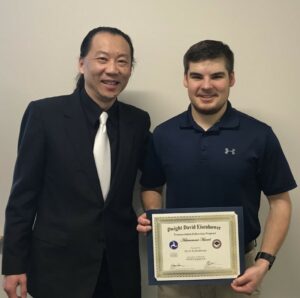Kaltenbronn, a Civil and Environmental Engineering graduate student, was one of less than 200 students nationwide to earn a Dwight D. Eisenhower Transportation Fellowship from the Federal Highway Administration (FHWA). His work to aid research that will improve transportation for people in Missouri and nationwide was exactly what the FHWA was looking for.
The program “advances the transportation workforce by helping to attract the nation’s brightest minds to the field of transportation, encouraging future transportation professionals to seek advanced degrees, and helping to retain top talent in the U.S. transportation industry.” The fellowship provides funding and the opportunity for recipients to present their research at the Transportation Research Board Annual Meeting, held in January in Washington, D.C.
“I was kind of surprised, to be honest,” Kaltenbronn said. “It was a little after they anticipated making the announcement, so I figured I didn’t get it, but then I saw the email that said I had won. I was very happy to find out.”
Kaltenbronn’s research focuses on the use of tethered surveillance drones, which are able to visually assess traffic conditions and collect traffic data at areas such as work zones and incident scenes. Drones used for this purpose typically have a short battery life, but tethered drones are connected to a power source while allowing for a bird’s eye view of a fixed area.
“Drones are becoming a lot more prevalent in the transportation industry, and one of the biggest issues is they can’t fly for very long. These devices could look into traffic monitoring at work zones, traffic incident scenes and scenes where you need more rapid deployment and can’t just pick up the images from a fixed camera,” he explained.
Despite being relatively early into his graduate school career, his research focus piqued the interest of the FHWA. The fellowship provided a validation of sorts for Kaltenbronn, who didn’t begin his collegiate career as an engineering major and had little interest initially in graduate school.
“I started as pre-med, went to business for a little bit and finally just kind of settled into engineering. I think Dr. Sun’s intro to transportation engineering class really got me into it,” he said.
“Once I started to do undergraduate research, it was pretty interesting, and I realized there was an opportunity to continue doing it. With such a great opportunity, I couldn’t turn down the chance to go to grad school.”
